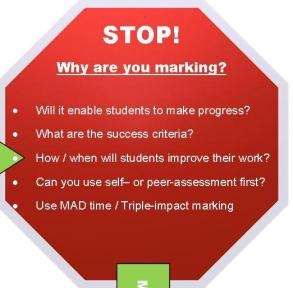This week’s 15-minute forum was led by new Leader of English Tom Daly on the subject of marking, assessment and feedback. Tom isn’t on Twitter yet, but we’re working on it!
Why do we mark? It’s a question I believe we should all ask ourselves; if we can’t answer it well enough, we really ought to stop.
I don’t actually believe we ought to stop marking though. Far from it, I actually think that where marking is selective and focused on quality – rather than quantity – feedback, then it’s one of the most important strategies in our toolkit. I just think we need to be clear on its purpose.
The ‘STOP’ sign above is a close-up of our T&L placemat, now on the teacher’s desk in every Wellacre classroom. It hopefully serves as a daily reminder that marking in and of itself is not necessarily useful, and that we should be honest with ourselves about why and how we choose to mark. To my mind, there are broadly three reasons:
- To help our students improve
This clearly has to be our starting point. Giving feedback to students is perhaps the most important element of our job. I always tell students that me marking their book is like free private tuition – the time when, without distraction, they have access to what I, as an expert, think about their work and how they can improve. Embedding time within schemes of work and lessons to allow students the chance to respond to this feedback is crucial. Equally important here is the idea of responsive marking – we won’t necessarily mark every students’ book in the same way, and that’s a good thing. If we know our students as well as we should, then we’ll also know what kind of feedback will work best for each. This can be a highly effective form of differentiation without leading to more work on our part.
- To motivate our students
Perhaps the most important single act we can engage in to help ‘get students onside’ is marking. It is a bit of a teaching cliché, but showing we care through our marking will result in the vast majority of students (certainly not all – it’s no magic wand!) giving us that care back in spades. Nothing demotivates a student like their book seemingly being ignored: “If my teacher isn’t working hard for me, why should I work for them?”
- For our own professional wellbeing
We have to be realistic and consider our own professional status. What do our books say about us as practitioners? Yes, in the first instance they are the students’ books, but they’re ours too. They are a reflection on us – the work planned for lessons, the work produced by students as a result and the feedback given (and acted upon!) as a result. I know that I feel empowered every single time I mark a book – it makes me feel (usually!) secure that I am giving students’ meaningful experiences. Striking the balance between marking for students and marking for ourselves is always going to be a contentious issue, but there were some really positive comments shared during the forum that suggest colleagues are finding our new feedback policy has already reduced the hours they were spending previously, and allowing much less marking to have a much greater impact on students (I know there’s another post from Ben in the pipeline on this too… watch this space!)
What does Ofsted say? (or, is freedom a good thing?)
According to the latest mythbusting guidance from Ofsted (17th October 2014), they:
- DO NOT expect every piece of work to be acknowledged with a tick or otherwise.
- DO NOT expect to see a particular frequency or quantity of work in pupils’ books or folders. Ofsted recognises that the amount of work in books will often depend on the age and ability of the pupils.
- DO NOT expect to see unnecessary or extensive written dialogue between teachers and pupils in exercise books and folders. Ofsted recognises the importance of different forms of feedback and inspectors will look at how these are used to promote learning.
- DO NOT specify how planning should be set out, the length of time it should take or the amount of detail it should contain. Inspectors are interested in the effectiveness of planning rather than the form it takes. This last bullet point is important for us because one of the ways we can show the effectiveness of our planning is through the feedback we provide. After all, marking is planning, and if I’m choosing to spend some of my Sunday afternoon giving feedback on a set of books, then I need to reap the benefit in terms of time that I don’t need to spend planning their next lesson.
The discussion at the end of the 15-minute forum was very much around whether this supposedly ‘liberating’ guidance is actually all it’s cracked up to be. Opinions will certainly vary, but I don’t think anyone really disagrees that what makes students learn well and make progress hasn’t changed much in the last hundred years and probably won’t in the next hundred, and we should be careful not to confusing shifting guidance with shifting standards. In other words, we should mark because we can answer for ourselves the questions from the top of the post, and we believe in the impact our marking is having. Not because someone is telling us to.


Pingback: Marking: what’s important to us? | Making Our Best Better
Pingback: Marking: how much is too much? | Making Our Best Better